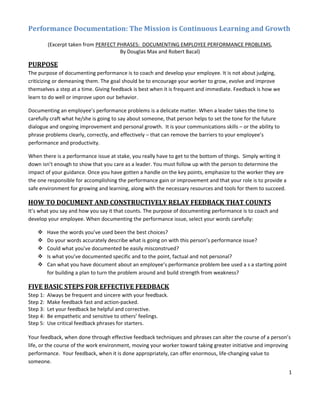
Performance Documentation The Mission Is Continuous Learning And Growth (2)
- 1. Performance Documentation: The Mission is Continuous Learning and Growth (Excerpt taken from PERFECT PHRASES: DOCUMENTING EMPLOYEE PERFORMANCE PROBLEMS, By Douglas Max and Robert Bacal) PURPOSE The purpose of documenting performance is to coach and develop your employee. It is not about judging, criticizing or demeaning them. The goal should be to encourage your worker to grow, evolve and improve themselves a step at a time. Giving feedback is best when it is frequent and immediate. Feedback is how we learn to do well or improve upon our behavior. Documenting an employee’s performance problems is a delicate matter. When a leader takes the time to carefully craft what he/she is going to say about someone, that person helps to set the tone for the future dialogue and ongoing improvement and personal growth. It is your communications skills – or the ability to phrase problems clearly, correctly, and effectively – that can remove the barriers to your employee’s performance and productivity. When there is a performance issue at stake, you really have to get to the bottom of things. Simply writing it down isn’t enough to show that you care as a leader. You must follow up with the person to determine the impact of your guidance. Once you have gotten a handle on the key points, emphasize to the worker they are the one responsible for accomplishing the performance gain or improvement and that your role is to provide a safe environment for growing and learning, along with the necessary resources and tools for them to succeed. HOW TO DOCUMENT AND CONSTRUCTIVELY RELAY FEEDBACK THAT COUNTS It’s what you say and how you say it that counts. The purpose of documenting performance is to coach and develop your employee. When documenting the performance issue, select your words carefully: Have the words you’ve used been the best choices? Do your words accurately describe what is going on with this person’s performance issue? Could what you’ve documented be easily misconstrued? Is what you’ve documented specific and to the point, factual and not personal? Can what you have document about an employee’s performance problem bee used a s a starting point for building a plan to turn the problem around and build strength from weakness? FIVE BASIC STEPS FOR EFFECTIVE FEEDBACK Step 1: Always be frequent and sincere with your feedback. Step 2: Make feedback fast and action‐packed. Step 3: Let your feedback be helpful and corrective. Step 4: Be empathetic and sensitive to others’ feelings. Step 5: Use critical feedback phrases for starters. Your feedback, when done through effective feedback techniques and phrases can alter the course of a person’s life, or the course of the work environment, moving your worker toward taking greater initiative and improving performance. Your feedback, when it is done appropriately, can offer enormous, life‐changing value to someone. 1
- 2. The Process Begins: Documenting Performance Problems is an Ongoing Challenge THE PROCESS IS ONGOING Documenting performance problems is an ongoing challenge when you want to bring an employee’s performance up to optimum level. Doing so requires a process that should accomplish the following objectives: 1. Quickly identify and uncover obstacles to an employee’s performance and success. Do this soon, rather than later, whenever possible. 2. Help provide the person, as quickly as possible, with what he/she needs to eliminate those obstacles that stand in the way of improved performance and ongoing success. 3. Be honest and straightforward in your documentation. When you set clear expectations, you are preparing the employee for success rather than failure. FOSTERING THE COMMUNICATION There are two kinds of managers. One manager is dead set on making others feel small or lesser, so that he or she can feel bigger or more important. The other manager is committed to people first. That type of leader takes time to learn to communicate clearly and explain his/her actions so that others can learn and develop from that important and vital feedback. How you foster the communication between you and your employees is up to you, but here are a few suggestions: Practice management by walking around (MBWA) Ask employees for ongoing status reports on projects. Hold weekly meetings with employees to evaluate overall direction and review what has been accomplished. Provide lots of helpful and corrective feedback. Use one‐on‐one communication when a performance problem arises. Never ridicule or point out someone’s problems in front of others. The objective of documenting performance challenges is to help employees to correct and learn from their mistakes, not to bury them in list s of weaknesses and performance failures. If you can’t back it up don’t say it! 2